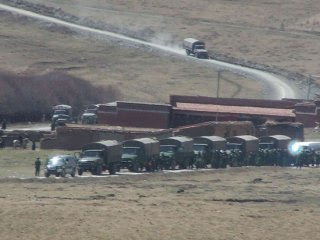Agam's Gecko


Tuesday, June 24, 2008
NEWS FROM BEHIND THE NEW IRON CURTAIN
| S |
mall and peaceful demonstrations have continued in Kardze County (in Kardze Prefecture, Sichuan), always with the same outcome: those who demonstrate their conscience are beaten severely and disappear into the Chinese security system.
In our last round-up of events in Tibet, on June 19, such incidents were reported for June 14, 15, 17 and 18. In addition to the three nuns seriously beaten with iron rods by the People's Armed Police and the Public Security Bureau officers, and arrested on June 17, two more nuns from Geyma Drak Nunnery School protested the next day and got the same treatment.
It's not known where Dhungtso and Drashi Tso were taken, but there are reports that nuns arrested in Kardze County have been moved to Dartsedo, the prefecture capital. Geyma Drak has around 120 nuns, some of whom were arrested in April.
A number of similar peaceful protests took place in Kardze County on June 18. Three monks from Bheri Monastery (including both the former and current chant masters) mounted a peaceful demonstration around 11 am that day at county government headquarters, but their fate remains unknown. One more Tibetan was arrested there after peacefully protesting on June 19.
On the same day, June 19 at around 2 pm, Ghayou, a monk from Koetsa village in Serthar County, Kardze Prefecture hoisted a Tibetan national flag and called for Tibetan independence and for Dalai Lama's swift return and long life. A large number of people gathered and were about to join him when many Chinese police blocked them and arrested the monk.
In a separate incident (date unknown) a monk was found to have taken photographs at the launch of the political re-education campaign in Choktsang Toema village, in Serthar County. He was severely beaten and arrested; his relatives' appeals to the authorities were answered by demands for 20,000 yuan -- a huge and impossible amount.
Three Tibetans who work harvesting wild Yartsey Gonbo (caterpillar fungus) in Kardze County returned from their collecting expedition on June 15, and were appalled at the arrests of so many of their people. They decided to take action against the brutality, and launched a peaceful protest at 10 am that day inside the Kardze market.
While one held a portrait of His Holiness above his head, the other two passed out leaflets calling for Dalai Lama's long life and swift return to his people, and the release of all political prisoners including the 11th Panchen Lama Gendun Choekyi Nyima. The men shouted out similar appeals, as well as called for independence and for China to get out of their country. The PAP pounced, and heavily beat them before hauling them off in a waiting military vehicle.
Due to the number of recent demonstrations in Serthar County, there is a heavy Chinese military deployment and a very tense atmosphere. In one area, Shetoe Phugu Shang, Tibetans have carved their language into the hills, where a large inscription now reads, "Tibet's Independence." People have filled in the letters with white stones to make it more visible.
A lot of Chinese troops have poured into the Kardze and Ngaba Prefectures, which are the Tibetan "Autonomous" jurisdictions within Sichuan.
In Sichuan province about 70,000 troops have been deployed in Tibetan towns and villages to prevent fresh outbreaks of unrest.The difference being, in Iraq it's the majority of the people, along with their democratically elected government and the assistance forces helping at the invitation of that government, together against murdering terrorist Islamist fascists. In these parts of Sichuan, and elsewhere in Tibet, it's a totalitarian Party against its subjects.
All foreigners are banned from these areas. However, visitors who returned within the last few days described scenes of virtual siege in many villages. Troops manning machineguns have been deployed on the fringes of most communities. Chicanes have been thrown up to force vehicles to slow down for checks and rolls of anti-tyre spikes are ready to be thrown down across roads in case of trouble.
One Chinese visitor said: "It looks like Iraq. It's as if there's a war."
On the primary day of the Tibetan holy month Saga Dawa ( the 15th day, full moon), which fell on June 18, another 12 monks were reportedly arrested at Sera Monastery, Lhasa, for protesting. The same day, gunshots were heard from inside Drepung Monastery, Lhasa. An eyewitness reported that PAP officers had opened fire into the air, to warn the monks against protesting in the monastery.
In an update to last week's report of monks in Barkham County, Ngaba Prefecture (like Kardze located within Sichuan province) removing foisted Chinese flags from their monastery, it appears they actually destroyed both the flag and pole. As a result, no one is allowed to enter or leave their institution, except for the greater numbers of PAP who have been deployed there. The monks are being "interrogated" to find who had committed this "serious crime."
On June 22, the day after Her Harmoniousness' visit to their capital city, two monks from Khangmar Monastery in Kardze County peacefully protested at the county government office at around 11 am, and were arrested by PAP and PSB officers. Later in the day at 1 pm, two more monks from the same institution protested peacefully and were beaten and arrested by PAP and PSB officers. At around 3 pm more than 10 more people, led by a layperson this time, mounted a peaceful protest at the same offices while also passing out pro-independence pamphlets. The security forces launched tear gas, severely beat them and then took them all away. At all these demonstrations, the aspirations expressed were, "Tibet is Independent," "His Holiness Must Return to Tibet," and "Long Live His Holiness Dalai Lama."
- The Chinese Government should invite His Holiness to Tibet
- Human Rights in Tibet
- Freedom in Tibet
- Stop the genocide in Tibet
- Withdraw all Chinese armies from Tibet
- Stop torturing the peaceful demonstrators with different inhuman instruments in Tibet, particularly in Kardze Area
- Release all Tibetan political prisoners
- Withdraw all Chinese armies surrounding the monasteries in Kardze area and stop condemning His Holiness the Dalai Lama and Tibetan Government in Exile
- No Olympic torch in Tibet and Tibet belongs to Tibetans
| A |
day after the torch show in Lhasa on Saturday, Buddhist pilgrims began returning to the Potala. But the Globe and Mail reporter had a question: Where are Lhasa's monks?
A visit yesterday to the Sera monastery, the second-biggest Buddhist monastery in Tibet, found that its 550 monks had virtually disappeared from sight. Most buildings and outdoor areas at the monastery were nearly empty, and only about 10 monks could be seen.After three days of travelling around the city, he realized that the monks had almost completely vanished from the city's streets. Police are stationed at all monasteries, which are under heavy surveillance. But the authorities produced one for the journalists' press conference -- the chief of Sera Monastery's "Democratic Management Committee," the Party's watchdog in all monasteries under the "Strike Hard" program.
Lobsang Choepel, a 77-year-old monk who heads the government-controlled administration at the Sera monastery, denied there were any restrictions on the monks. "They can go downtown to do shopping and they can go to the market to buy vegetables," he said yesterday. But he didn't explain why so few monks were visible on the streets or in the monastery itself.When will Lhasa return to "normal" (normal for the capital of an occupied country, as opposed to regular normal)? Many Tibetans are said to believe the security clampdown will diminish after the torch show, hoping that tourists may soon return. But a Chinese analyst of Tibet issues told the Times the opposite is more likely.
After giving brief answers to five questions from foreign journalists, the monk was hustled away by Chinese officials, who refused to permit further questions.
"I think that once the Olympics are over we will start to see the real crackdown.
"Now the authorities worry about international opinion, but once the Games are over there will be a settling of accounts. Then we will see many people being sent to jail and even tougher measures to restore order."
| A |
new report by the International Campaign for Tibet, released on the eve of the Lhasa torch show, contains much new information, eyewitness testimony and some dramatic new photos (some of which you can see here, but go there for the full resolution pictures and report).
This report contains a very interesting preliminary analysis of events since March, produced from the documentation of 125 separate incidents of dissent across the plateau. Of these, 47 were carried out by monks (or nuns, I would infer), 44 by laypeople, and 28 by both religious and laypeople. The majority of these incidents took place in the Tibetan areas of Sichuan (Kardze and Ngaba Prefectures). Around 14 involved violence against property, although on March 14 in Lhasa, Chinese civilians were also attacked.
Security forces fired on, killed and wounded unarmed demonstrators in at least 11 separate incidents across the plateau. These protests occurred in Lhasa on March 14; in Ngaba (Chinese: Aba) TAP in Sichuan province on March 16; in Serthar (Chinese: Seda) county in Sichuan on March 17, 18 and 20; in Chigdril (Chinese: Jiuzhi) county in Qinghai province on March 17; in Drango (Chinese: Luhuo) county in Qinghai province on March 24; in Tawu (Chinese: Daofu) county in Sichuan on April 5; and in Jomda (Chinese: Jiangda) county in the TAR on April 8. There are conflicting reports on the events in Kardze on March 18, and insufficient information in many other cases. On May 28, a 21-year old Tibetan student, Rinchen (or Rigden) Lhamo, was shot in the leg after she called for the return of the Dalai Lama to Tibet and the release of Tibetan prisoners outside the Kardze county government headquarters.Here we have the first confirmation that Rigden Lhamo, on whom witnesses saw blood as she was taken away following the sounds of gunshots (reported here on June 1), was indeed shot by the security forces.
Many of the protests were clearly in direct response to the authorities' political re-education campaigns (see report for details), which were intensified in March. Several were primarily expressions of sympathy for those killed, and appeals for leniency for those arrested.
Among the measures put into place in Lhasa during the religious festival of Saga Dawa this month is a heightened undercover presence of security forces. Police and informers patrol the streets dressed as beggars and pilgrims. And even children are not spared from being used to intimidate their families.
A Tibetan source told ICT: "Teachers at one kindergarten told children that they would be expelled if their relatives attended ceremonies for Saga Dawa."A communications blackout continues to be imposed, and Tibetan families who have received a phone call from outside the country often get an immediate visit from the internal security people. In one case, a young woman was so severely beaten for taking such a call that she required hospitalization.
"In every political prisoner's cell there are two criminal prisoners, one Chinese and one Tibetan, to watch what the political prisoners are doing and talking about. Every week those two criminal prisoners would attend a meeting with the prison authorities and would report what they saw and heard in the cell... Sometimes they would even report our dreams, as we might have said something relating to a political event."The same former prisoner reports that the cells have video cameras in each corner of the room, and audio recording as well. But many Tibetans rounded up in Lhasa have also been moved to far distant Sichuan or Qinghai facilities, with hundreds reportedly moved out at a time by train.
The dramatic image of an invasion of military vehicles and soldiers at Tsendrok Monastery in Mayma township, Machu County, Kanlho Prefecture (Ch: Gansu) is one of three published in the report. On the morning of April 18, the large convoy arrived without warning from Lanzhou, carrying hundreds of armed soldiers.
"The soldiers barged into the monastery, conducted random searches, and broke down doors, windows, and other objects." They cooked food for themselves from the monastery's supplies, and when they left that evening, took with them a number of valuable and precious religious artefacts, according to the same source, a Tibetan in exile with connections in the area. The monastery has reportedly filed a complaint based on the confiscation of the artefacts...Foreign journalists on a government media tour visited two monasteries in Machu County the day after they had been at Labrang (where monks demonstrated their feelings to them in an unauthorized way on April 9). Prior to the visits in Machu, propaganda officials gave the monks precise instructions.
According to reports circulating in the area, local Tibetans are disturbed by other actions of security personnel now entrenched in Machu - in particular, news has reached ICT of soldiers or armed police shooting and eating Tibetan mastiff dogs, and also taking cash from monasteries where patriotic education is being enforced.
"If you are asked about your opinion on the Dalai Lama you should respond by saying that you oppose a free Tibet and will always oppose activities aimed at separating the country." The monks were also advised to say that they accepted the Chinese recognized Panchen Lama, Gyaltsen Norbu, and not the boy recognized by the Dalai Lama, Gendun Choekyi Nyima, who is in Chinese custody.As the Globe and Mail reporter said a few days ago, Chinese government-sponsored media tours are no way to actually gather news. You'll gather something, but it won't be news. The only way for journalists who have a genuine interest in covering this story to get anything worthwhile, is to get their feet dirty. It won't be easy, but sneaking around is the only way to get the real story.
On the day the press arrived, monks were made to give prayers in the main hall of the monasteries and army personnel were stationed out of sight. According to the same report, "Police officers were given Tibetan laypeople's clothes and asked to circumambulate the monastery holding prayer beads."
But some should definitely keep covering the official media tours. They are great producers of real laughs in this dark time for Tibet. ("Lhasa is normally closed on Saturdays.") Heh.
.











 Our way of saying "thanks" in the Thai way. Here a nak muay Thai (kickboxer) offers respect and thanks for his teacher (wai khru) before a match. This is our local variation on the ubiquitous "hat tip" used in general blog culture.
Our way of saying "thanks" in the Thai way. Here a nak muay Thai (kickboxer) offers respect and thanks for his teacher (wai khru) before a match. This is our local variation on the ubiquitous "hat tip" used in general blog culture.









